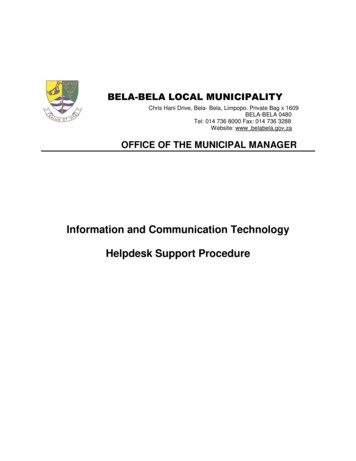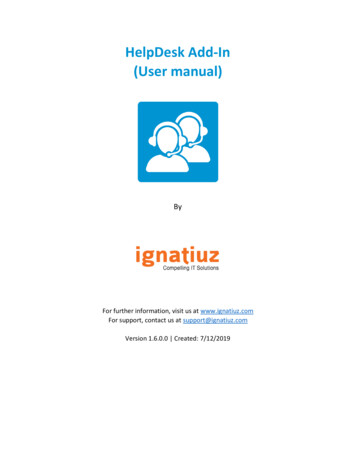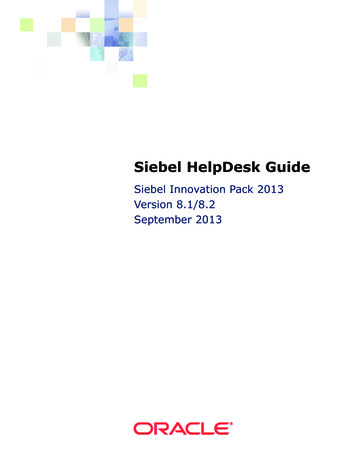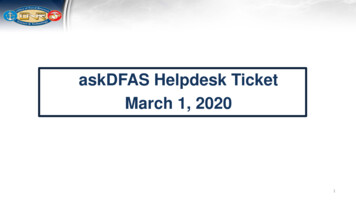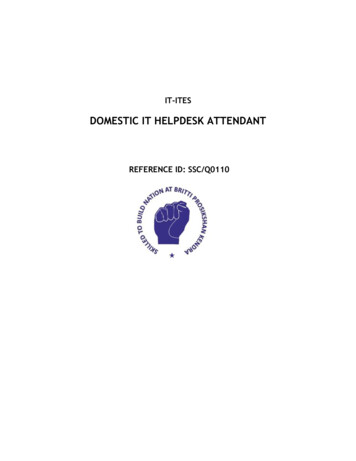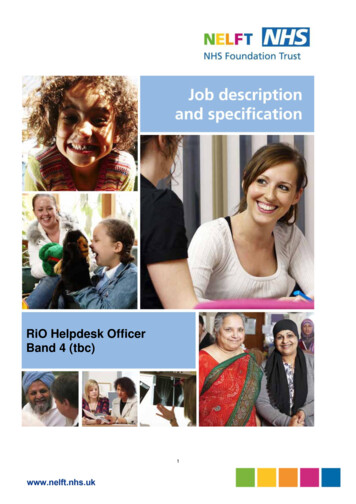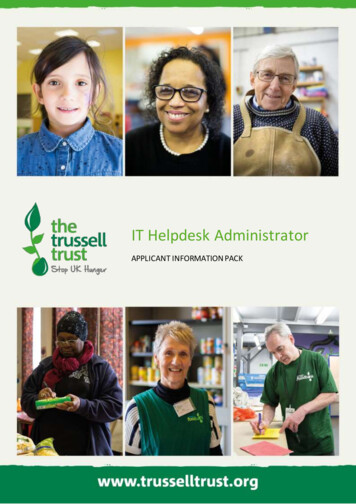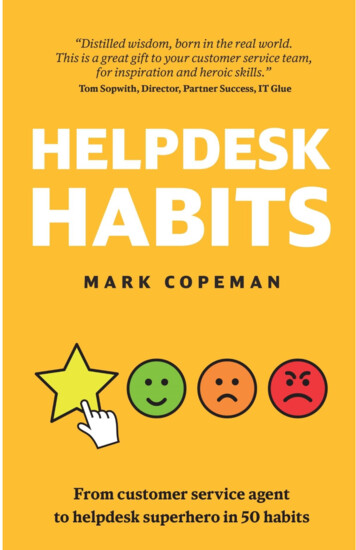
Transcription
i
Helpdesk HabitsSAMPLERMark CopemanLearn how to create and embed the right habits.Become a helpdesk superheroand make yourself indispensable.
“The subscription economy is drawing therelationship between your customer supportteam, reputation and brand ever closer.As a result, your support and serviceoperation holds one of the keys to yourcompany’s growth and profitability.Mark’s excellent, practical guide will provide asolid framework for anyone looking to build acareer in support, or assist management intraining and developing the skills, mentalityand contribution of their team.”Lindsay WillottCEO, Customer Thermometer
Copyright 2019 Mark CopemanAll rights reserved.
FOREWORD . 7INTRODUCTION . 10The ACETS pyramid . 21Introducing the pyramid . 22Attitude . 23Communications . 23Emotions . 23Tactics . 23Superhero habits . 24ATTITUDE . 25Introduction. 26The service recovery paradox. 27COMMUNICATIONS . 30Introduction. 31Lay it out . 33EMOTIONS . 36Introduction. 37What’s really going on?. 38TACTICS . 42Introduction. 43Understanding urgency . 44SUPERHERO HABITS . 46Introduction. 47Never assume . 49
ACKNOWLEDGMENTSWriting this book has fulfilled a dream of mine.I needed to get to the ripe old age of 47 to feel inspired enough to write it. That inspirationhas come from many people. Many of whom are referenced within the habits.My ex-business partner, Lindsay Willott, CEO of Customer Thermometer deserves the firstmention. Without her tenacity and drive, my Customer Thermometer journey would havebeen much shorter and much less enjoyable. I learnt a huge amount from her during ourtime together. I must thank the amazing Customer Thermometer team too for theircamaraderie and good nature during our 8 years together. I learnt so much from you all.My family have been a huge inspiration to me over the years. My dad is mentioned severaltimes in the habits. With his retirement looming, there’s not much he doesn’t know aboutdealing with customers and people. I think he’s passed down some of that intuition.Suzanne, my wife has taught me more than I’ll ever know. Not necessarily about customerservice, but about life and how to get the most from it. Kind, generous, supportive andcaring, I lucked out when we met 25 years ago. Matthew and Lucy, our children, inspire meconstantly and secretly seem quite proud of having a dad who’s written an actual book.I’m incredibly grateful to Jon Blakey and Tom Sopwith who were the first to read the bookand provide a generous foreword, quotes and reviews. As two people I respect hugely in theIT support industry, I’m humbled by your kind words.To the customers and colleagues, I’ve worked with over the last 25 years, thank you forhelping me learn the art of rapport, empathy and customer service. I’ve got tougher over theyears – but only because I know that’s what you want.Finally, I want to mention Daniel Priestley, author and founder of Dent Global. His booksare inspirational. When I met him, he told me I needed to write a book. I now have.
Helpdesk Habits - SAMPLERFOREWORDBy Jon Blakey, CIO, The 20BUY THE FULL VERSION AT HELPDESKHABITS.COM/BOOK7
Helpdesk Habits - SAMPLERAs the great American writer Maya Angelou once said,“I've learned that people will forget what you said,people will forget what you did,but people will never forget how you made them feel.”From my personal experience working in customer service, as I putmyself through college, to later on as an IT support technician, Ifound this to be 100% true. I used this as my motto and continuedstudying. Over the next decade, I have built a team of technicians andtrained others on our team to hire for our industry-leading 24/7support desk.In my continued attempts to perfect hiring of the “ultimatetechnician”, I came to find that this belief is not all that common,and the attitude and helpdesk habits that Mark talks about in thisbook should be the base foundation to becoming a support desk“superhero”.There are few books that address the personal attitude lens you mustview customer service through, alongside the practical application ofsupport desk habits that most companies struggle to put a finger on,which leave you feeling less than stellar about your client interactions.I wholeheartedly believe that if you are in technical support, customerservice, or have any part in hiring or training for these roles, this bookis a must-read to rapidly increase competency and turn yourcompany’s hiring team into one that identifies and trains rock staragents. Putting these principles into place will be a key differentiatorfor your business.In my role as CIO of The 20, an industry-leading IT service company,customer satisfaction is a key metric. I met Mark when we engagedhis company, Customer Thermometer, to assist us with developingan improved software platform to better support our end clients.Mark’s focus on the seemingly small things, even in his interactionBUY THE FULL VERSION AT HELPDESKHABITS.COM/BOOK8
Helpdesk Habits - SAMPLERwith us, as a perspective client, was evident in our very first demo oftheir software. He created and prominently displayed a custom imagecombining The 20’s logo with his own, helping us visualize ourpotential future partnership. This was probably a routine practice forhim, but I still remember the impact it had on me.As I got to know Mark, his expertise in customer service becameoverwhelmingly apparent. Questions about why his customersatisfaction gauge had four options instead of three (which I assumedwas an arbitrary “because four is an even number and I like evennumbers”) was met with his citing of a psychological study that whenpresented with an odd number of options to rate, peopleoverwhelmingly choose the middle option. As a service company, aneutral rating is essentially useless. By providing four options, thecustomer is forced to choose a positive or negative rating, resulting inmore meaningful data.With the help of Mark’s vast knowledge of customer service, we’velearned about the necessity of tracking customer feedback, coupledwith it being quick and easy, and the importance of responding whenwe receive average or poor feedback. This has helped us attain a highnineties percentage average with good or great feedback for manyyears now using the same principles he has now outlined in this book.So, soak up every bit of this information and remember, as every goodsuperhero knows, “with great power, comes great responsibility.”Now, go out and be someone’s helpdesk superhero!BUY THE FULL VERSION AT HELPDESKHABITS.COM/BOOK9
Helpdesk Habits - SAMPLERINTRODUCTIONBUY THE FULL VERSION AT HELPDESKHABITS.COM/BOOK10
Helpdesk Habits - SAMPLERWho will benefit from this book?There are plenty of authors who concentrate on team work, helpdeskmanagement, systems, bots, AI, automation and reducing headcount.That’s not for me. I’m leaving them to do what they do best. I wantto focus on us poor neglected humans.“Human customer service” is a phrase I’m passionate about. Yes, thebots will come and go, but if I know human beings, we’re going towant to interact with real people for decades to come. We as humansneed to get better at having these interactions and stop hiding behindour bots and our knowledgebases. If we do, not only will yourcustomers have a better day, you will too. I promise.You will benefit from this book if you are involved in customer servicein any capacity. Account managers, finance, marketers, HR (you havecustomers too, remember) will all find benefit. Developing new habitswill mean you will think twice before sending that next email.If you are a helpdesk agent or manager in the IT or software world,then this book is written specifically for you. Whether you are part ofa service desk inside a large corporate organisation or a 5-personcompany helpdesk, I’ve seen with my own eyes the difference a focuson customer service and measuring the quality of that service canmake. The topics in this book are practical and actionable and willhelp you make change as quickly as tomorrow.The modern helpdesk spans many types of platform and so whetheryou spend your days on chat, on email threads, on the phone orforums, there’s some habit forming gems in here for you.If you spend the majority of your time speaking (as opposed towriting) to contacts, call centre agents will benefit from the habits andexamples shown in the book too. The concepts span both the writtenword and speech.BUY THE FULL VERSION AT HELPDESKHABITS.COM/BOOK11
Helpdesk Habits - SAMPLERIt was timeHelpdesk Habits has been bubbling inside me for many years. I amthat person who gives feedback, good or bad on a customer serviceexperience. As I’ve got older, I’ve naturally got grumpier and thoselittle customer service moments now really matter to me. If anything,they’re amplifiedWhen an agent says or does (or doesn’t) do something which just isn’tright, it really does bother me. I’m assuming these types of behaviourstherefore bother others. I can’t be the only one, can I?It costs five times as much to attract a new customer,than to keep an existing one.Sometimes I struggle to believe that agents don’t realise the impact ofwhat they’re doing or saying.Isn’t it obvious when they’re not getting it right?Isn’t it intuitive?Having spoken to and worked with 100’s of people around the worldabout customer service, satisfaction and loyalty over the last ten years,the simple answer to those questions are that no, good customerservice, rapport and that sense of duty isn’t necessarily intuitive.The majority of people are not born with the customer service ‘gene’and intuition to just do the right thing. To succeed, they need to besat down and taught it.As someone who has always had customer facing jobs, this has mademe curious. Why don’t people naturally do the right thing? Go theextra mile? Say and do the right things?The conclusion I’ve come to, is that customer service is a skill andlike any skill, it must be learnt. Unless you’re taught to embrace thisethos and develop the right habits, many don’t know why they shouldBUY THE FULL VERSION AT HELPDESKHABITS.COM/BOOK12
Helpdesk Habits - SAMPLERbehave in certain ways, how to behave and importantly, understandwhy it matters so much.Well, let me tell you, it really does matter.Whether it’s the (big German car manufacturer) service rep on thephone, blaming me for not booking a ‘waiting car serviceappointment.’ I didn’t know this was a feature and wasn’t even giventhe option for this feature Whether it’s the 1 hour 15 minute wait for that curry delivery, whenyou’ve been promised 20 mins Whether it’s the airline taking 90 mins to rebook a flight theycancelled and refused to call back (because the landline battery wasabout to give out) It matters.And yes, they’ve all happened to me over the last couple of months.Can a customer ethos service be taught?Maybe.Can you be taught tactics, practice them regularly and aim to turnthem into habits over time?Definitely.“Our character is basically a composite of our habits.Because they are consistent, often unconscious patterns,they constantly express our character.”Stephen CoveyStephen knows a thing or two about habits, and writing for thatmatter, so I’ll happily go along with his thinking on this. If ourcharacter is made up from our habits, and we get good at practicingBUY THE FULL VERSION AT HELPDESKHABITS.COM/BOOK13
Helpdesk Habits - SAMPLERcustomer service habits, then who says we can’t eventually becomenatural at customer service?This book aims to provide a series of “Aha” moments, and not in anAlan Partridge way (for UK readers) through a series of short essays,my aim is to show you the way, alongside practical suggestions of thewords to be using, whether written or verbal.Each topic can and should be used for conversation, in team meetingsor in 1:1’s. It’s been proven that changing habits is easier when doneas a group. Alcoholics Anonymous is an extreme, but excellentexample of this happening every day.There’s something really powerful about groups and sharedexperiences. People might be sceptical about their ability tochange if they’re by themselves, but a group will convince them tosuspend disbelief. A community creates belief.Lee Ann Kskutas, Alcohol Research GroupA word on habitsI’d like to thank Charles Duhigg for his book, The Power of Habit. It’shelped me to understand the power of developing and embeddinghabits and why they occur. It’s a fascinating read.There are three parts to forming or changing a habit:The cue or trigger: something which you recognise as being the causeof a particular behaviour.The routine: the behaviour following the trigger, which could bephysical or emotional.The reward: where the brain decides whether a habit is worthdeveloping and filing under ‘automatic mode’.BUY THE FULL VERSION AT HELPDESKHABITS.COM/BOOK14
Helpdesk Habits - SAMPLERThis is known as the habit loop.Over time, these loops become more and more automatic, until ahabit is born, and the anticipation and a sense of craving willeventually emerge.Creating, changing or embedding a habit means firstly recognisingthe trigger which causes the routine or behaviour. If you can identifya trigger – the thing that you’re doing to cause that bad behaviour orresult, then you can work to change that behaviour, once triggered.The reward at the end of each habit loop also needs to be worthwhile,for a new habit to embed.At the end of each topic, you’ll see a box summarising the old andnew habit loops. Master the art of creating and changing habits andyou’ll be set for life.What makes me qualified?I’ve spent a lifetime in customer service. From the moment I leftschool and went to university, my fledgling DJ career saw me workingsociety and hall balls at different venues all over Bristol here in theUK.Skills such as empathy and rapport come in very handy at 2am whensomeone is screaming in your ear to play a particular record that youdon’t have. For readers under 40, there was a time when you didn’thave every track ever produced in the palm of your hand. Ask yourparents.I had to learn quickly about how to deal with people – take theirrequests, apologise if I couldn’t fulfil them, interact with thepromoters and venue managers and deal with more than my fair shareof problems. The wedding booking that ended up being a last-minutebirthday gathering was an interesting evening. This job was my firstBUY THE FULL VERSION AT HELPDESKHABITS.COM/BOOK15
Helpdesk Habits - SAMPLERexperience of understanding how getting on with people can achievegreat things.I started my career in the UK’s largest telco provider and wascustomer facing from day one, working with customers across allkinds of different projects. When you’re working for such a largecompany, it may surprise you to know that things don’t always gosmoothly. I therefore realised early on, that customers are relying onyou as an individual to be the conduit into the beast that is BT, (BritishTelecom), to get things done. Without tenacity and persistence andcommunication, your customer could easily be left hanging. Yourinvolvement could often make a tangible difference to their day.In 2000, I started the first of my two marketing and video productionagencies. When you’re running your own business (as I have doneever since), customer service underpins your whole day. You’re notgoing to succeed if you don’t get that part of your role under control.You deal with the good times, but you learn most in times of crisisand in small business, there’s often crisis!In 2010, I earnt the equivalent of my masters in customer service, asI co-founded Customer Thermometer, the still very awesome 1-clicksurvey feedback tool. When you start a SaaS (software as a service)business, particularly back then, where there was very little writtenabout the start-up world, you really don’t know what you’re getting into.When you’re starting a business, which focuses and supports those inthe customer service domain and you’re looking to provide supportvia your own helpdesk (as I spent a lot of my time doing in the earlydays), then you must learn quickly.Over the course of those 8 years, I presented the service to 100’s ofpeople I answered tickets from 1,000 people and helped to createBUY THE FULL VERSION AT HELPDESKHABITS.COM/BOOK16
Helpdesk Habits - SAMPLERa team, which to this day continues to support a growing customerbase.I learnt that customers were lazy, ignorant, wonderful, humorous,frustrating, rewarding and each one unique.Customer service truly is the differentiator in this space. Howfascinating it was to see our customers spreading the word about theawesome Ministry of Magic we set up, as we empowered our team, toalways do the right thing.So many of the lessons we learnt, are in this book. They aretransferrable across all types of businesses but will resonateparticularly in the IT and software helpdesk world.A life changing experienceBefore we dig in to the good stuff, I did want to tell one story, whichwill stay with me forever, for all kinds of reasons. Over time, it hashelped to shape me and has made me really appreciate the value goodcustomer service can bring.It was a Friday afternoon in May 2012. (Why is it always a Friday?) Igot a call from a customer of ours. They were one of the first adoptersof the service and had put a huge amount of faith in our service toget results. They were a FTSE 100 organisation.Unknown to us, they had used their account to do something we’dnever seen before. They’d sent a survey to tens of thousands of people.It’s not something we’d ever tested at the time as we were only a fewmonths into our evolution. They had sent that survey to one of theirbiggest customers (also FTSE100). Senior execs from both sides weresat in the same room, eagerly staring at giant dashboards, waiting forresults to come in, in real time.The phone call was a bolt out of the blue. The customer told me thatthe CIO of the receiving organisation had received multiple copies ofBUY THE FULL VERSION AT HELPDESKHABITS.COM/BOOK17
Helpdesk Habits - SAMPLERthe survey and they were getting complaints of spam from across theirbusiness.I wanted the ground to swallow me up.I got on the phone to the team to dig into the issue and we quicklysaw there had been an issue. The software hadn’t been able to processthe surveys fast enough and so had started sending duplicates andtriplicates and so on.Phone calls kept coming in from more and more irate execs. The factthey were in the same room made the situation worse. I literally feltsick.Fortunately, we didn’t have many customers at this point and so weshut the service down for the afternoon and went into fact findingand debugging mode. I could feel the weight of this company’s legalteam on our shoulders and all I wanted to do was to run away.We worked tirelessly all weekend. We coded, we ran tests, thoughtthrough solutions and wrote a 20 page document for our customer,which identified exactly what happened, pinpointed exactly who gothow many duplicates, described our remedial plan and I got ready topresent it back to them on Monday afternoon.By putting in that effort, by not putting our heads in the sand, by notgiving up and facing up to the issue, we were subsequently told it wasthe best remedial report they had ever seen (clearly, they had seen afew in their time).8 years on, they were still a massive customer, the service had spreadto multiple divisions and people became advocates for the service,both within the organisation and outside of it.That story for me, typifies the power of providing great service, andthat is what I want to instil in you, through habit forming topicsBUY THE FULL VERSION AT HELPDESKHABITS.COM/BOOK18
Helpdesk Habits - SAMPLERwhich you will have the joy of practising over the coming weeks andmonths. Get it right and it’s tremendously rewarding.I felt it important to note, that after that moment back in 2012, thesoftware’s sending routines were re-engineered and for many years,Customer Thermometer has continued to process thousands ofemails each day without incident!VocabularyBecause there are so many titles for people involved in the helpdeskworld, I have tried to keep the language simple. I refer to an agent,throughout, which is interchangeable with operator, technician,engineer, team member, representative or whatever phrase refers tosomeone customer facing in your organisation.Helpdesk could also mean service desk, internal support desk, sharedservices, IT support, customer service team, customer support or anyother department dealing with inbound queries. Helpdesk fits nicelywith the word ‘habits’, which was a good enough reason for me tosettle on it.I refer mainly to ‘customers’ throughout the book. The term couldequally refer to internal customers, prospects, subscribers, citizens,clients or consumers.You’ll see I refer to my previous business from time to time. I’mindebted to my experience founding and growing CustomerThermometer and my ex-business partner and good friend, LindsayWillott. I learnt so much about the customer service world, how toget customer service right and saw first-hand how companies strugglewith getting it right.Finally, there are many examples of both good and bad customerservice throughout. I deliberately obscure the names of the companiesinvolved. It would be wrong to single them out as either good or badBUY THE FULL VERSION AT HELPDESKHABITS.COM/BOOK19
Helpdesk Habits - SAMPLERproponents of customer service, when I could have easily chosendifferent examples to paint them in a different light.Now I’ve got things into context, I hope you are up for creating somenew habits. First, we need a simple framework.BUY THE FULL VERSION AT HELPDESKHABITS.COM/BOOK20
Helpdesk Habits - SAMPLERThe ACETS pyramidBUY THE FULL VERSION AT HELPDESKHABITS.COM/BOOK21
Helpdesk Habits - SAMPLERIntroducing the pyramidLike any skill in life, you have to work at it. You can’t wake up onemorning and have everything you need at your fingertips. It takestime, it takes practice. It takes experience.All skills have to be taught from the ground up. You have to build ona platform and get the basics in place before you can move up to thenext level. You can’t train a pilot to land a 747 successfully if they’venot mastered the theory of flight and landed a Cessna 152 hundredsof times.Every business book needs a good framework, because it helps readersto piece together a jigsaw of new ideas as well as the ability to putthem into practice. Without a framework, without structure, it’smuch harder to explain how new ideas fit together and readers aremuch less likely to adopt them.The ACETS (pronounced ‘Assets’) pyramid provides you with astructure for your habit building. You can see the skills and habitsyou must master, before moving up the pyramid towards becoming aHelpdesk Superhero.The ACETS pyramidBUY THE FULL VERSION AT HELPDESKHABITS.COM/BOOK22
Helpdesk Habits - SAMPLERAttitudeGetting your attitude right, towards your role and your customers isthe widest part of the pyramid. When you come into work with thewrong mindset, there’s little point in remembering the rest of theHelpdesk Habits, as if your attitude is wrong, you will fail at the firsthurdle and the pyramid will collapse.CommunicationsThe American personal development guru, Paul J Meyer said that“communication is the key to personal and career success”. He’s right. Ifyou can learn to communicate effectively (and I’m not talking aboutjust spelling and grammar), then most other things will fall into place.This is why it’s the second layer of the pyramid. Without thesefundamental habits instilled, you can never truly master the art ofcustomer service.EmotionsBeing a helpdesk agent often means taking on the skills of acounsellor and a therapist too. The general public (or your company’semployees) will be challenging at times. People will often come acrossas irrational and emotional. Understanding how to read the signalsand deal correctly with that emotion is critical. I’ll also examine habitsto handle your own emotions too, which can become frayed duringpressurised days.TacticsWith the fundamental habits in place, the pyramid can then continueto build by introducing tactics you can use every day, to make yourlife and your customers’ lives easier. I want to encourage you to adoptthe art of ‘human customer service’. By developing these tacticalBUY THE FULL VERSION AT HELPDESKHABITS.COM/BOOK23
Helpdesk Habits - SAMPLERhabits, you’ll ensure customers are treated like royalty and will keepcoming back for more.Superhero habitsThere’s a lot to remember and practice in the first four layers of thepyramid, particularly if customer service doesn’t come naturally toyou. I hope by this point you’ll have built more confidence in yourrole and will then have the capacity to excel. To use Seth Godin’strademark word, building a remarkable helpdesk requires Superherohabits. I aim to give you food for thought and the tools to help youand your team progress through the final layer of the pyramid.That’s enough preamble – it’s time to get started.BUY THE FULL VERSION AT HELPDESKHABITS.COM/BOOK24
Helpdesk Habits - SAMPLERATTITUDE“In the end, it’s not going to matter how many breaths you took,but how many moments took your breath away”– Xiong ShengBUY THE FULL VERSION AT HELPDESKHABITS.COM/BOOK25
Helpdesk Habits - SAMPLERIntroductionI think it’s important to be honest and I recognise there is a possibilityyou’re being asked to read this book, when a helpdesk environmentisn’t necessarily your passion. Instead, you’re doing the job as a meansto an end. If this is the case, then it’s possible you’re not going to beoverly receptive to some of the ideas I put forward. I want to addressthis issue right away.There are three types of people who will read this book. Someone who is in a temporary helpdesk position. They areworking purely for the money, as a stop gap before a new startsomewhere else.Someone who is in a helpdesk career, who perhaps doesn’tenjoy it, feels stuck, but has commitments, so stays in theirposition.Someone who loves the helpdesk environment and enjoystheir job.If you’re in the third category, this layer of the ACETS will act moreas a reminder than a pep talk.If you’re in the first two categories, then my aim is to motivate andenergise you. Do read on.Everyone has to do things in life they don’t always want to do. Yourattitude towards your role will greatly affect your mental health, theway you’re perceived and the opportunities which present themselvesto you over the coming years.This fundamental layer of the pyramid aims to put you into a positivemindset as you start each day.BUY THE FULL VERSION AT HELPDESKHABITS.COM/BOOK26
Helpdesk Habits - SAMPLERThe service recovery paradoxI opened this book with a catastrophic failure (catastrophic as far as Iwas concerned at the time). Something went seriously wrong duringthe early days of our business. Our biggest customer at the time wasangry, frustrated and embarrassed. As I mentioned, our diligence sawus through. At the heart of that diligence however was honesty. Wewere completely transparent about the problem. The customer didn’tneed to know everything, but they demanded answers (quite rightly),and we provided them.Mistakes happen all the time in business. It’s part of life. Whilst theimmediate effect and impact may not be great, customers generallyunderstand that things do go wrong.What you do to fix an issue and how you react to it,is what really matters.The service recovery paradox is a concept I’ve talked about endlesslyfor the last 8 years. When it was first pointed out to me graphically,it made a big impact on my thinking.The service recovery paradoxBUY THE FULL VERSION AT HELPDESKHABITS.COM/BOOK27
Helpdesk Habits - SAMPLERThe service recovery paradox states that if you deal with a customerproblem successfully, that customer is likely to be more loyal to youover time.Let me rephrase that, for impact If a customer has a service failureand you resolve that failure in professional manner to a customer’ssatisfaction, that customer will talk about you more, refer you moreand become more l
training and developing the skills, mentality . If you are a helpdesk agent or manager in the IT or software world, then this book is written specifically for you. Whether you are part of a service desk inside a large corporate organisation or a 5-person company helpde
